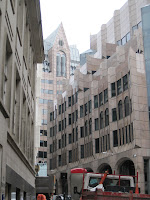20.6.11
We are talking about the old quarter of St. James. Many years ago, along with the square mile of the City of London, this area was all there was to London. All around them was countryside.
The story of St. James' Palace really begins with Henry V111 when he brought his bride (second wife Anne Boleyn) here for their honeymoon. It was then a hunting lodge and had been developed from a leper hospital.
All that now remains of the original hunting lodge is the gatehouse - today the clock tower. Up till the time of Queen Victoria monarchs spent time here, especially after the Palace of Whitehall burnt down in 1698, when the Court was centred here.
St. James' Palace is still used sometimes as a royal palace. Prince Charles lived here after his separation from Princess Diana, although he moved next door to Clarence House after his grandmother died. Diana's body lay in state here the night before her funeral. Today there are some grace-and-favour appartments here.
The man who came up with the plan to create a new, fashionable 'West End' was Henry Jermyn, the Earl of St. Albans. St. James' Square was the first part of the new area to be completed. In 1684 a new church, designed by Sir Christopher Wren, was built and called
St. James' Piccadilly.
 |
| inside the church |
|
It was during the reign of Charles 11 that the area gained some notoriety as a place where the wealthy kept establishments for their mistresses. Two of Charles 11's mistresses lived near here - Barbara Castlemaine and also Nell Gwyn. These 'ladies' were the style icons of the day and were socially acceptable in public, if not in private!
The area also became something of a domain for the gentleman of the day, starting with the coffee houses, many of which later became gentlemens' clubs. There are still some there today - Brooks is one of London's most exclusive gentlemens' clubs, founded in 1764 by 27 men, including four dukes. It was a meeting place for
Whigs. Across the road is 'Boodles' and further up the road is 'Whites' - the oldest of the clubs in this area. One of its most famous members is Beau Brummel who used to sit in the window so that passers-by could benefit from seeing his fashion choices! David Cameron's father was a chairman there. Members of the Royal Family usually become members of this club.
The area's shops are expensive and independent, individual and old-fashioned.
Fortnum and Mason is the most famous. Its fortune was built on candle wax! Apparently, William Fortnum was a footman in service to Queen Anne. She liked to have all the candles in the palace replaced each night with new ones - the resulting stubs were sold on by Fortnum and, eventually, he was able to open a modest shop with his landlord, Mr. Mason.
Another of the grand houses in this area is
Spencer House built for the first Earl Spencer, an ancestor of Diana Spencer, Princess of Wales. The house is now owned by the Rothschilds and used as their headquarters during the week. It is possible to visit the house at the weekend and it is well worth it. The interiors were conceived as a showcase of classical design.
 |
| View of the house from Green Park |











































